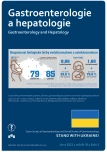The importance of home parenteral nutrition in clinical practice – own experience from our workplace
Authors:
Fojtová A. 1,2; Norek B. 2; Gazdíková K. 3
Authors‘ workplace:
IBD centrum, UN Bratislava
1; Gastroenterologická klinika SZU a UN Bratislava
2; Katedra všeobecného lekárstva LF SZU v Bratislave
3
Published in:
Gastroent Hepatol 2022; 76(1): 60-66
Category:
Clinical and Experimental Gastroenterology: Review Article
doi:
https://doi.org/10.48095/ccgh202260
Overview
Home parenteral nutrition is an alternative route and form of nutrition in patients with irreversible intestinal failure in whom enteral nutrition is not possible or is insufficient in the long run with an increasing energy deficit. Starting parenteral nutrition at home improves the quality of patients’ life and consequently also the course of the underlying disease, with optimization of clinical manifestations of malnutrition. The most common indications for home parenteral nutrition include large reductions of the absorption area due to intestinal resections (Crohn’s disease surgical complications, ischemic small bowel necrosis due to thrombosis in the superior mesenteric vein or embolism or atherosclerotic occlusion of the superior mesenteric artery, but also intestinal failures of different aetiology and cancer with sufficient utilization of essential nutrients).
Keywords:
complications – short bowel syndrome – home parenteral nutrition
Sources
1. Fojtová A, Norek B, Zamborský T et al. Domáca parenterálna výživa – význam a využitie v klinickej praxi. Gastroent Hepatol 2015; 69 (5): 449–452. doi: 10.14735/amgh2015449.
2. Pironi L, Boeykens K, Bozzetti F et al. ESPEN guideline on home parenteral nutrition. Clin Nutr 2020; 39 (6): 1645–1666. doi: 10.1016/ j.clnu.2020.03.005.
3. Odborné usmernenie organizácie klinickej výživy č. 13163/2006 v znení Odborného usmernenia č. 06242/2008-OZS, vydanom vo Vestníku MZ, čiastka 1–3/2009.
4. NHS National Commissioning Group for highly specialised services. Strategic framework for intestinal failure and home parenteral nutrition services for adults in England 2019. [online]. Available from: http: //www.specialisedservices.nhs.uk/library/28/Strategic_Framework_for_Intestinal_Failure_and_Home_Parenteral_Nutrition_Services_for_Adults_in_England_1. pdf.
5. Bozzetti F, Santarpia L, Pironi L et al. The prognosis of incurable cachectic cancer patients on home parenteral nutrition: a multicentre observational study with prospective follow-up of 414 patients. Ann Oncol 2014; 25 (2): 487–493. doi: 10.1093/ annonc/mdt549.
6. Dreesen M, Foulon V, Vanhaecht K et al. Guidelines recommendations on care of adult patients receiving home parenteral nutrition: a systematic review of global practices. Clin Nutr 2012; 31 (5): 602–608. doi: 10.1016/j.clnu.2012.02.013.
7. Popálená J. Katétrové infekcie u pacientov v programe domácej parenterálnej výživy. [online]. Available from: https: //worldmednet.cz.
8. Dreesen M, Foulon V, Spriet I et al. Epidemiology of catheter-related infections in adult patients receiving home parenteral nutrition: a systematic review. Clin Nutr 2013; 32 (1): 16–26. doi: 10.1016/j.clnu.2012.08.004.
9. Gahlot R, Nigam C, Kumar V et al. Catheter-related bloodstream infections. Int J Crit Illn Inj Sci 2014; 4 (2): 162–167. doi: 10.4103/ 2229-5151.134184.
10. Pittiruti M, Hamilton H, Biffi, R et al. ESPEN guidelines on parenteral nutrition: central venous catheters. Clin Nutr 2009; 28 (4): 365–377. doi: 10.1016/j.clnu.2009.03.015.
11. SSPEV. Manuál a video pre pacientov na DPV. [online]. Available from: https: //sspev.sk/manual-a-video-pre-pacientov-na-dpv/.
12. Robert M, Doneghan P, Graber M et al. Heparin stimulates staphylococcus aureus biofilm formation. Infect Immun 2005; 73 (8): 4596–4606. doi: 10.1128/IAI.73.8.4596-4606.2005.
13. Noelting J, Jurewitsch B, Allard J. Non-antibiotic antimicrobial catheter lock solutions in patients on home parenteral nutrition. Nutrients 2018; 10 (9): 1165. doi: 10.3390/nu10091165.
14. Blot K, Bergs J, Vogelaers D et al. Prevention of central line-associated bloodstream infections through quality improvement interventions: a systematic review and meta-analysis. Clin Infect Dis 2014; 59 (1): 96–105. doi: 10.1093/cid/ciu239.
15. Gabe SM, Culkin A. Abnormal liver function tests in the parenteral nutrition fed patient. Frontline Gastroenterol 2010; 1 (2): 98–104. doi: 10.1136/fg.2009.000521.
16. Ondrušová M, Maronová M, Slezáková J. Analýza veľkosti cieľovej populácie pacientov so syndrómom krátkeho čreva. 2019 [online]. Available from:: https: //www.pharmin.sk.
17. Pironi L, Goulet O, Buchman A et al. Outcome on home parenteral nutrition for benign intestinal failure: a review of the literature and benchmarking with the European prosective survey of ESPEN. Clin Nutr 2012; 31 (6): 831–845. doi: 10.1016/j. clnu.2012.05. 004.
Labels
Paediatric gastroenterology Gastroenterology and hepatology SurgeryArticle was published in
Gastroenterology and Hepatology

2022 Issue 1
Most read in this issue
- Desmoid fibromatosis – a rare mesenteric tumor
- Remsima SC 120 mg – a new generation of biosimilar drugs
- The importance of home parenteral nutrition in clinical practice – own experience from our workplace
- Doporučení Pracovní skupiny pro idiopatické střevní záněty pro diagnostiku a medikamentózní léčbu ulcerózní kolitidy
